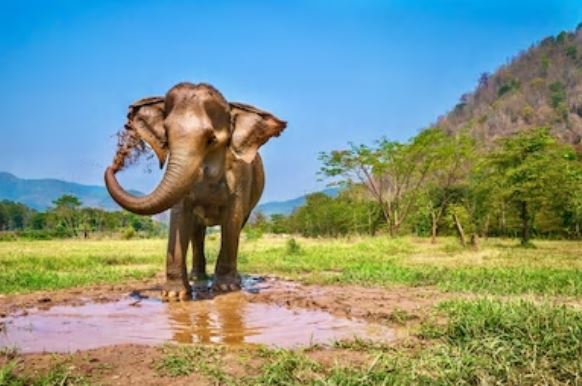This summer, we have had some extraordinarily hot days, with Europe facing heat waves that broke records! So it is likely that you had to cover up and slather yourself in sun cream- or face getting burnt… But I found myself wondering, plants need the sun to survive, so the age-old advice of ‘stay in the shade’ isn’t exactly viable: So why do plants not need sunblock? What about other animals?
First of all, why do plants need light? Plants don’t eat food, so instead, they have to create their own using photosynthesis! As you may guess from the name, photosynthesis needs the photons in light- particularly red and blue light, to produce ATP and other molecules that can then react further to produce sugars. This part of photosynthesis is called the Light dependant reactions, and takes place within the chloroplast. The chloroplast is what contains the pigment chlorophyll that absorbs the light and reflects green frequencies, hence why plants look green. Inside the chloroplast is an organelle called the thylakoid, and it is at this membrane that ADP (a common molecule that is the product of respiration) is turned into ATP- a vital molecule for energy release in respiration. How does light do this? The photons excite the electrons (give them more energy) in the Hydrogen found in water, causing the electron to be released. This electron is then transferred between molecules, releasing energy that is used to funnel Hydrogen ions into the thylakoid, creating a concentration gradient, which then forces the Hydrogens back out (because, diffusion) through a part of the membrane called the ATP synthase. The hydrogen ions act like water turning a millwheel, which can turn the ADP into ATP.

Image from a Khan Academy video
So obviously, to stay in the shade would be a very bad idea for the plant!
However, sunlight isn’t just made up of Visible Light, but also quite a lot of Ultraviolet. The photons in an ultraviolet beam of light have more energy, and a higher frequency, so it is this that causes damage. UV light is split into 3 main categories: UVA. UVB, and UVC. UVC is the weakest wavelength, and is mostly blocked by the atmosphere, so it is only a bit of a problem for astronauts! UVB is what causes the top layer of skin to burn, blister and peel, and UVA penetrates deeper into the skin, causing cells to produce more melanin and make you tan, but can also cause permanent damage and change DNA, leading to skin cancer. And it’s not only to us that it can cause damage- exposure to UV rays can also cause DNA to change in many organisms, including plants.

UV exposure to plants can hinder their growth, as it can damage the structures used in photosynthesis! To prevent this, plants produce molecules called sinapate esters that get sent to the upper epidermis on detection of UV. These act in much the same way as melanin in the human body, absorbing and blocking every wavelength of UVB. This is actually a relatively recent discovery, made by a team led by Timothy Zwier in 2014. They tested it by isolating one of the molecules- sinapoyl malate- cooling it to near-absolute-zero and suspending it in Argon (to prevent evaporation), before subjecting it to ultraviolet radiation! There are no plans to develop it into a sunscreen for us, as there is already a similar molecule used, but it is possible that it could be used in the development of genetically engineered plants that are more able to survive the heatwaves that are becoming ever more common.
Different plants have evolved to have different amounts of these sunblocking molecules and mechanisms, much like how people have different concentrations of melanin. With Climate Change bringing more frequent heat waves, more frequent clear skies could result in plants that have evolved to withstand lower levels of UV could experience leaf scorch- plant sunburn!

In fact, it isn’t just plants that can produce their own sunscreen:
- Like many animals (and teenagers), when Hippos get hot, they sweat! But their sweat has a red pigment, which acts as a sunscreen and is antibacterial!
- Zebrafish, along with some birds and reptiles, have an ancient gene that allows for the production of gadusol- a compound found most commonly in fungi and bacteria- that is resistant to UV.
- But like how the best way to beat the sun is to cover up, most animals survive with a thick layer of fur to protect them, that can block or reflect the sunlight.
Alternatively, animals like elephants, rhinos and pigs cover themselves in mud or dust, to act as a barrier to the sunlight!

Who knows? Maybe in the future we will be able to change our genes so that we no longer have to worry about the dangers of UV radiation… until then: reapply that sunscreen!
☆☆☆
If you can’t trust an atom… trust in science!
☆it’s like magic, but it’s true whether you believe it or not!☆
See you next time!
☆☆☆
Do you know of any other organisms that can protect themselves from the sun? Or some facts about the sun/ sunscreen that I have missed? Let me know in the comments!



I loved this article! I am going to use this when I teach my junior high students about photosynthesis and the energy from the sun. It is crazy to think how even plants, the masters of light absorption and utilization, can take a hit from some form of energy from the sun. I also love the tie in to climate change and cancer, two very hot topics right now. Keep up the great work!
LikeLike
Thank you so much! It is such a fascinating topic and I hope your students enjoy it!
LikeLike